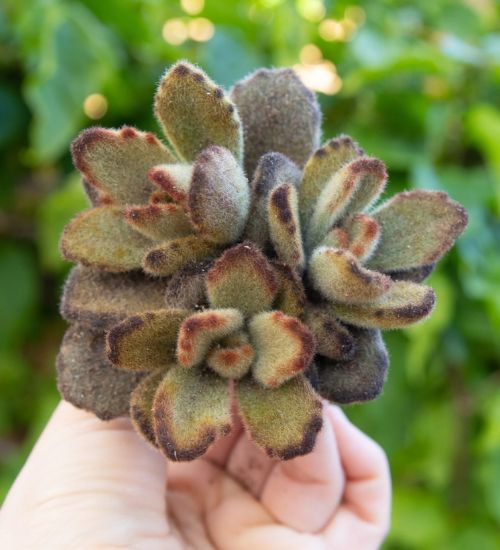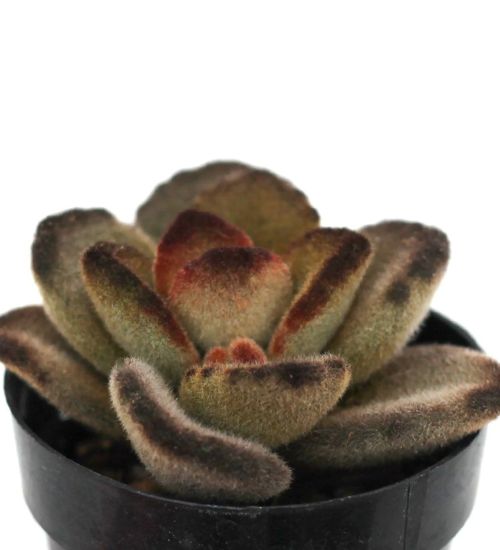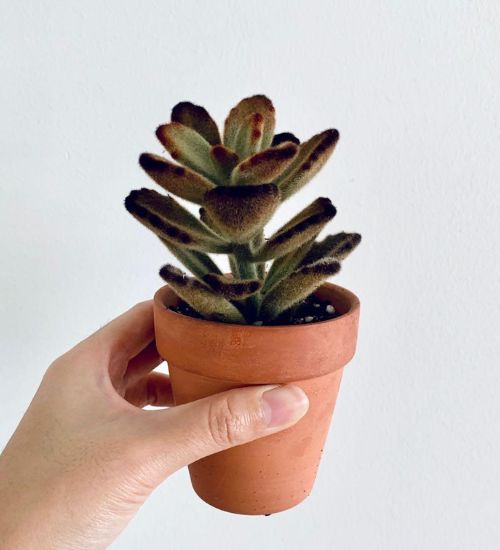Sun: Bright indoor light
Water: Typical water needs for a succulent
Temperature: Zone 10a from 30° F to 35° F (-1.1 ° C to 1.7° C)
Winter Survival: Not cold hardy
Propagation: leaves, stem cuttings
Flower:
Flower Type: Yellow
Toxic: Toxic to humans and animals
Dormant: summer
Space Requirement: Indoors & Outdoors
Common Problems: Plants may rot if overwatered, pests
Where to buy Kalanchoe tomentosa ‘Teddy Bear’?
Basc Care for Kalanchoe tomentosa ‘Teddy Bear’
Watering
What you need to remember is that this type of succulents needs to be watered for every 2 weeks
You can water your succulent more than often in extreme conditions but make sure that the soil is completely dry before watering your succulent again.
Fertilizing
Only feed this succulent during its active growing seasons which means winter. Use the right fertilizer applied in the right amounts. Applying half-strength balanced fertilizer every month or so is recommended for optimal results.
Do not fertilize during summer as the plant is dormant.
Sun & Location Requirements for "Kalanchoe tomentosa ‘Teddy Bear’"
Kalanchoe tomentosa ‘Teddy Bear’ needs plenty of bright light in order to stay healthy. Consider placing your succulent near a window that gets direct sunlight for part of the day. If natural light isn’t an option, invest in an LED grow-light or other artificial lighting to provide enough light for Kalanchoe tomentosa ‘Teddy Bear’ to thrive.
As per this succulent profile, it is only able to stay healthy when the environment temperature is above the range of zone 10a from 30° F to 35° F (-1.1 ° C to 1.7° C).
In order to ensure that Kalanchoe tomentosa ‘Teddy Bear’ survives the winter, insulation and drainage are essential. A layer of mulch or gravel around the plant can help keep the roots warm during cold temperatures. Furthermore, avoiding exposure to wind and sun can reduce the risk of frost damage and promote longevity for your succulent.
Any succulents in the group will need a medium space to grow. You can place your pot at your table or window. Since this plant needs more space than mini succulents, you should consider do not plant them together with other succulents/plants.
Kalanchoe tomentosa ‘Teddy Bear’ also benefits from some indirect light throughout the day as well, so make sure you give it enough space to soak up light without becoming too exposed to heat.
Propagation
Propagating succulents with leaves is a satisfying way to obtain new plants. Start by cutting some healthy leaves from the mother plant, then place them on top of potting mix and water regularly. In time you'll have vibrant succulents that you grew yourself!
Propagating Kalanchoe tomentosa ‘Teddy Bear’ by stem cuttings is a simple process that requires very few supplies. Start by selecting healthy stems from existing plants that are at least two inches long and have several leaves attached.
Toxicity

Kalanchoe tomentosa ‘Teddy Bear’ is a highly toxic succulent that should be treated with extreme caution to avoid serious health risks. If ingested, it can lead to severe gastrointestinal distress, respiratory problems and even death. It is best to keep this plant away from homes or gardens where humans or animals reside.
Pests and Diseases
Kalanchoe tomentosa ‘Teddy Bear’ can be affected common pests and diseases like most of the other succulents such as mealybugs.
If you do spot any of pest signs, you can treat your succulent using below methods.
- Mealybugs: quarantine, clean infected plants, soapy water.
Besides that, to prevent serious health issues from happening, keep your succulent in a well-ventilated area and check it regularly for any signs of pests or health problems.


